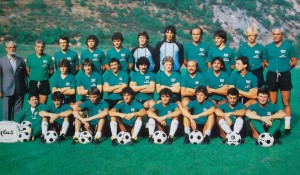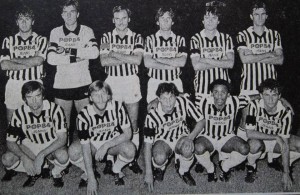The Bundesliga. In the 20th season of the league only 9 from the original members were still playing in it and some of them already spent at least one season the lower divisions. That is probably just a curious note, for there is no way clubs to stay strong for ever and the original members were invited, they did not qualify. Presently, the picture was very different from the one 20 years ago, but almost as a tribute to the anniversary the championship was incredibly intriguing and competitive – not at the bottom, but at the top: 5 teams fought tremendous battle for the title, three of them finishing by equal points and the championship was decided by goal-difference. Whatever the quality of football was, such a championship was big rarity and big thrill. At the bottom the picture was different. Two teams were hopeless outsiders.

1. FC Nurnberg was dead last with 14 points – nothing surprising. The team distinguished itself, though – they lost all 17 away games. At least in West Germany, it was not at all normal a team to be so weak away from home turf. Hard to believe that players like Kargus, Burgsmuller, the Swiss star Botteron could be that weak.

Kickers (Offenbach) ended 19th with 19 points – also not a surprise.

Eintracht (Frankfurt), in decline by now, finished 16th with 27 points. They were involved in a at least 7-team battle for survival and got the short stick. However, they still had a chance to keep their place in the league – if winning the promotion/relegation play-off with the 3rd placed team in the second division. This Eintracht did, beating MSV Duisburg at its home 5-0, thus making the second leg meaningless – it ended 1-1 in Frankfurt, but no matter.

VfL Bochum finished safely at 15th place with 28 points. Barely surviving, but they were specialists at that – Bochum was amazing team: never having even relatively strong squad, as names go, but able to year after year to avoid relegation, sometimes even climbing to the first half of the final table. One looks at their squad this year and like every year before wonders how come this team is not last.

By now, Fortuna (Dusseldorf) was like Eintracht (Frankfurt) – in decline. For the same reason: the club failed to start rebuilding on time, players aged without young talent pushing forward. And current efforts seemingly were not in the right direction: aging Kleff and Zewe were hardly the players to build a team around. Their best years were well in the past, retirement was the future. Well, survived relegation this season – 14th with 29 points.

A year or two ago Borussia (Dortmund) was bright, ascending team, expected to grew stronger. But no… somehow the team stuck and now it looked like they were not going to be the next German wonder. Still, the team was too good to be in the relegation zone – it may have been just a temporary slip, but even so it was clear that they were not on the road to glory any more. 13th with 30 points.

1. FC Kaiserslautern finished 12th with 30 points. Nothing really surprising, for this club was never stable – one year great, the next a failure. Escaped relegation, which was not that bad after all.

SV 07 Waldhof also managed to escape relegation – that was pretty much the most this club could dream of, but thanks to the weaknesses of the competition, they finished 11th with 31 points. From their standpoint – very good season.

Bayer (Uerdingen) – 10th with 31 points. Also managed to escape relegation – that they finished quite high was just a bonus. May be at this time Bayer focused on the other Bayer in the league and Uerdingen became the second-team of the giant firm. That largely meant difficulties in keeping descent squad, but this was possible only in Germany: two teams with one owner playing in the same league. May be Uerdingen was getting less money, but there was no doubt both teams played fair – no fixing, no helping the ‘first’ team. Same name, but the clubs operated as entirely independent entities.

Eintracht (Braunschweig) finished 9th with 32 points. High place for them, but hardly strong season – they only escaped relegation, quite the typical performance.

Arminia (Bielefeld) ended 8th with 33 points. Pretty much the same as Braunschweig – well placed, but nothing promising and generally concerned with avoiding relegation. Good coach, though.

Bayer (Leverkusen) – 7th with 34 points. Not a great record, but this was up and coming team, gradually getting respect and climbing up. Still in the building period, but it was serious project – Detmar Cramer was at the helm with purpose.

1. FC Koln – 6th with 38 points. Not to be underestimated, but this was team able only to stay high in the league. Not a title contender, that was clear for some time – just maintaining strong position. Hard to tell what did not work, but Rinus Michels was not able to push otherwise talented squad up – it looked stuck at one place.
The top 5 teams were involved in the tremendous battle for the title, quite above the rest of the league – the 6th ended with 38 points, the 5th – with 45. Big difference, immediately telling that the top five were different breed. The whole difference between them 3 points between the 1st and the 5th. All five were high scorers too – Koln was the closest to them with 70 goals, but the lowest scorers of the top five managed 75. Perhaps the top teams were equal this season and only misfortune divided them. Perhaps they were strong teams – certainly stronger than anybody else – but there was no great team among them: they were equal because of weaknesses. Something missing, not quite well rounded squads, something needed badly to make difference, but unavailable.

Werder took 5th place with 45 points. And here was exactly this problem suggested just before: bright, talented, rapidly ascending young coach Otto Rehhagel, making the best of strong squad, but based on old hands – Fichtel, Sidka, Okudera, Burdenski. Not enough younger talent – only Voller and to a point Reinders. Not enough classy players for a well rounded squad. Rehhagel could compensate with excellent coaching only to a certain point.

Bayern – 4th with 47 points. Udo Lattek was back at the helm. But he was no longer young climbing up coach – he reached the limits of his potential and the driving force now was not inspiration, but experience. Good team, but not really great, with some shaky positions. Durnberger, Karl-Heinz Rummenigge and Dieter Hoeness already reached the top of their potential and were only getting older. Del’Haye was in the same situation too. This was a moment of great reshaping, it was clear – this was not a great squad and it was no going further. Oh, they lost the championship by the tiniest of margins -1 point – but in battles like that, this was the big difference between loser and winner and there was little something missing to Bayern’s peril: 4th place. Still, the highest scoring team this season – 84 goals.

Borussia (Moenchengladbach) took 3rd place on worse goal-difference – they finished with the same points as the winners, 48. Looked like revival and there were high hopes that Borussia would build a great squad again – there was a good group of players and excellent young coach. Perhaps the sensation of the year was the coaching of Heynckes. Rarely great players transform into great coaches, but Heynckes was obvious talent in this field too. And he had a good mix of old, current, and future talent – Mill, Hannes, Matthaus, Kamps, Rahn, Ringels, Frontzeck, Bruns. The skeleton was at hand, even at his stage the team proved to be a winner, perhaps with few careful additions there will be another great and unstoppable Borussia. But the potential was endangered by traditional problem: Borussia never had money, so it was also clear that key players will be sold. And soon. That was objective danger, but it was not new and the club, in the same circumstances, managed to stay at the very top of Europe for the most of the previous decade. So, it looked like Borussia was ready to have another great team – and may be dominate the Bundesliga in the following years. Unlucky this year, but nothing tragic – just the opposite. But they needed a player or two.

Hamburger SV – 48 points, of course, having better goal-difference than Borussia, but not goodenough for the title. Unfortunately, 2nd place for them. Led by Happel, so nothing wrong there, but this was not a squad stronger than the one they had two or three years before. Stuck to a point… and in need of few players too. One thing was becoming clear by now – HSV was able to replace leading players, but was unable to recruit great players for the few relatively shaky positions. Hard to point a finger, but may be the problem was that HSV, having Magath and Kaltz, was unable to add another player of similar class to the team. No problem getting players at the level of Rolff, Hartwig, Hieronymus, Milewski – problem with getting players of higher class than those. Thus, winning the title became chancy – and eventually lost by very little, but lost.

It went to VfB Stuttgart and the boys were incredibly happy. Well, what could be said – given the rivals, it was great to prevail. But it was only on goal-difference… in some sense, even better than winning on points, in another sense – may be just lucky.

There was doubt that VfB Stuttgart built a wonderful team and said team reached its peak. It was noticed already, great things were expected from this squad and the victory justified expectations. However… it was a squad with some shaky points, it was not great on big scale. It was more or less equal to the squads of the rivals. Post by post, Stuttgart hardly had the best players – at almost every position the top player belonged to another club. There was also dark danger lurking nearby: it was almost certain that Stuttgart was going to lose some of the stars to Italian or domestic clubs: the Foster brothers and the Swede Corneliusson were the prime targets. Replacing them would be quite a challenge, so it was highly unlikely the club would be able to reinforce: it was a matter of keeping the already reached level. From this perspective, it was great they won the championship.




























































































